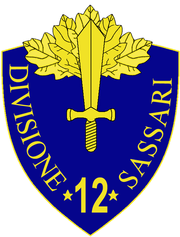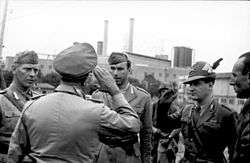12th Infantry Division Sassari
The 12th Infantry Division Sassari was an Infantry Division of the Italian Army during World War II. After the end of World War I the Italian Army disbanded all brigades raised during the war with the exception of the Sassari Infantry Brigade and three further brigades, which also had distinguished themselves during the war: Liguria, Arezzo and Avellino. The brigade moved to Trieste as part of the 12th Infantry Division Timavo'. In 1926 the brigade gained the 12th Infantry Regiment Casale and changed its name to XII Infantry Brigade. Along with the 34th Artillery Regiment the brigade were the only units of the 12th Division. In 1939 the brigade lost the 12th Infantry regiment and was renamed 12th Infantry Division Sassari. This binary division consisted of only two infantry regiments (151st and 152nd) and the 34th Field Artillery Regiment. To increase the weak strength of the division in 1941 the division was joined by the 73rd Blackshirt Assault Legion Boiardo, a battalion sized militia unit of the Italian Fascist Party.
| 12th Infantry Division Sassari | |
|---|---|
 12th Infantry Division Sassari Insignia | |
| Active | 1939–1943 |
| Country | Italy |
| Branch | Italian Army |
| Type | Infantry |
| Size | Division |
| Nickname(s) | Sassari |
| Engagements | World War II Battle of the Neretva |
| Commanders | |
| Notable commanders | General Giacomo Castagna |
Action

10 June 1940, the Sassari division was deployed on border defence duties at Venezia Giulia valley (near Borjana) As part of the Italian V Corps the division remained in Istria on garrison duty until 6 April 1941 when Axis forces began the invasion of Yugoslavia. The first Yugoslav cities to fall were Prezid and Čabar on 12 April, followed Novi Lazi and Borovec on 14 April. On 19 April the division reached Delnice, the following day Knin. For the next two years the division command remained in Knin, while the divisions units were continuously employed in anti-Partisan operations: in Šibenik, Brod na Kupi, Gračac, Petrovac and Drvar. The heaviest fighting occurred during July 1942 when the division tried to clean the Velebit mountains of Partisan forces.
In March 1943, after the Battle of the Neretva, the division transferred to Rome to aid in the defense of the city in case of an Allied attack. During this time the division was reorganized along the lines of the Mod.43 reform of the Italian Army and was augmented with the XII Mortar Battalion and the XII Semovente Battalion which was equipped with 24 Semovente 75/18 self-propelled guns. In total the division fielded 14,500 troops, 24 Semovente and 80 artillery pieces. After the Armistice between Italy and Allied armed forces of 8 September 1943 the division found itself fighting Italy's former allies the Germans and along with the 21st Infantry Division Granatieri di Sardegna and 135th Armored Division Ariete II the Sassari defended Rome for two days. On 10 September 1943 the remnants of the Sassari joined the 21st Infantry Division Granatieri di Sardegna and the 8th Cavalry Regiment Lancieri di Montebello and hundreds of civilian volunteers at Porta San Paolo for a last stand. Civilians at Porta San Paolo included communist leader Luigi Longo, lawyer Giuliano Vassalli, writer Emilio Lussu, unionist leader Vincenzo Baldazzi, Mario Zagari, retired Air Force generals Sabato Martelli Castaldi and Roberto Lordi, and 18-year-old future partisan leader Marisa Musu. The future Italian president Sandro Pertini brought a detachment of Socialist resistance fighters to Porta San Paolo and around 12:30 the Catholic Communist movement arrived with further reinforcements including famed actor Carlo Ninchi. However by 17:00 the Germans broke the line of the Italian defenders, who had suffered 570 dead. Soon after the Italian military units surrendered to the Germans as the flight of the Italian King Victor Emmanuel III from Rome had made further resistance senseless. However the Italian soldiers handed thousands of weapons over to the civilian population, which was quick to form an organized resistance movement in the city of Rome.
In 1988 the Sassari Mechanized Brigade was formed, which continues the tradition of the Sassari Division.
Commander
General Giacomo Castagna
Order of battle
- 151st Infantry Regiment "Sassari"
- I Infantry Battalion
- II Infantry Battalion
- III Infantry Battalion
- 152nd Infantry Regiment "Sassari"
- IV Infantry Battalion
- V Infantry Battalion
- VI Infantry Battalion
- 73rd CCNN Assault Legion "Boiardo"
- 73rd CCNN Battalion "Boiardo"
- 34th Artillery Regiment
- I Artillery Group
- II Artillery Group
- III Artillery Group
- XII Mortar Battalion
- XII Semoventi Battalion (with Semovente 75/18)
- 106th Motorized Machine Gun Battalion
- 5th Engineer Battalion
- CXII Mixed Engineer Battalion
- 12th Anti-tank Company (with 47/32 M35)
- 27th Searchlight Section[1][nb 1]
C.R.O.W.C.A.S.S.
The names of 8 men attached to the Sassari Division can be found in the CROWCASS List established by the Anglo-American Allies of the individuals wanted by Yugoslavia for war crimes:
- (Name) BARBA - (C.R. File Number) 250049 - (Rank, Occupation, Unit, Place and Date of Crime) Major, Sassari Div., Kistanje (Yugo.) 6.41 - (Reason wanted) Pillage - (Wanted by) Yugo. [3]
- BARBERO Pietro - 250048 - Col., XVIII Corpo di Armata Sassari Div., Biograd Betina, Vodice (Yugo.) 42 - Murder - Yugo. [4]
- BERARDI Pholo - 149616 - General, commander, Sassari-Div. (Yugo.) 1943 - Murder - Yugo. [5]
- BORRUZO Pietro 190904 - Major, Italian Army, 3. Btty., 151. Regt. Fanteria, "Sassari" Div., Fara Slovenia (Yugo.), summer 41 - Murder - Yugo. [6]
- GAZZINI (or GAZZINO) - 190971 - Col., Italian Army, Rgt. of Sassari Div. (F 559), Udbina Gracac (Yugo.) 1. and 2.43 - Murder - Yugo. [7]
- GIANOPECO Francesco - 147278 - General, Italian Army "Sassari"Div. (Yugo.) 43 - Murder - Yugo. [8]
- GLORIA - 147272 - General, Italian Army, "Lombardia" Rgt., "Sassari" Div. (Yugo.) 43 - Murder - Yugo. [9]
- ZANOTTI - 191020 - Col., Ital. Army, O.C. Regt., Sassari Div., F. 562, Udbina, Gracac (Yugo.) 2. and 3.43 - Murder - Yugo. [10]
Notes
- Footnotes
- An Italian Infantry Division normally consisted of two Infantry Regiments (three Battalions each), an Artillery Regiment, a Mortar Battalion (two companies), an Anti Tank Company, a Blackshirt Legion of two Battalions was sometimes attached. Each Division had only about 7,000 men, The Infantry and Artillery Regiments contained 1,650 men, the Blackshirt Legion 1,200, each company 150 men.[2]
- Citations
- Wendal, Marcus. "Italian Army". Axis History. Archived from the original on 30 April 2009. Retrieved 16 April 2009.
- Paoletti, p 170
- The Central Registry of War Criminals and Security Suspects, Consolidated Wanted Lists (1947), Naval & University Press, Uckfield 2005; Part 2 - Non-Germans only, p. 57 (facsimile of the original document at the National Archives in Kew/London).
- Ibid., p. 57
- Ibid., p. 58
- Ibid., p. 58
- Ibid., p. 64
- Ibid., p. 64
- Ibid., p. 64
- Ibid., p. 74
Further reading
- Paoletti, Ciro (2008). A Military History of Italy. Greenwood Publishing Group. ISBN 0-275-98505-9.